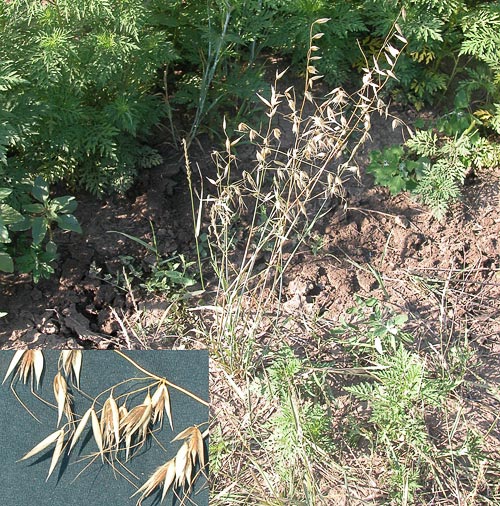Weeds
Avena fatua L. - Wild oats
Taxonomy.
Family Poaceae Barnhart. (Graminea), Genus Avena L. The following subspecies are described: A. fatua subsp. sertentrionalis Malz., A. fatua subsp. fatua, A.vatua subsp. meridionalis Malz., and A. fatua subsp. cultiformis Malz.Biology type.
Spring annual.Morphology anf biology.
Root system is fibrillose, well-developed. Stem reaches 60-120 cm in height, straight-stalked, glabrous. Leaves are linear, up to 30 cm in length, wide, with leaf sheath at the base, ciliated along edge, with uvula but unlobed. Inflorescence is a long, sprawling or compressed panicle. One plant bears up to 500 seeds. Evidently heterocarpous. The bottom part of each panicle contains large grains (about 70% of total amount). They remain in panicle for a period of more than 30 days and, when harvested, get mixed in with the grain supply and contaminates crop seeds. Top part of each panicle forms small grains (about 30% of total amount), which immediately fall to soil when ripe. Seeds germinate after hibernation. Sprouting occurs both at low (5-8°C) and high (20-30°C) temperatures. Germinating ability is maintained over 15 years.Distribution.
Scandinavia, Central, Atlantic, and Mediterranean Europe, Mongolia, and North America. Throughout the territories of the former USSR, excluding the Arctic, deserts and high mountains.Ecology.
Most abundant in steppe and forest-steppe zones of North Kazakhstan, west Siberia, Ural, and southeast of European Russia. In taiga and dry-steppe zones, occurs less frequently. Threatens agriculture across black-soil belt: Volga region, north Kazakhstan, and west Siberia. Dry, hot summer seasons with little precipitation are favorable; ecotopes with sufficiently high levels of soil fertility, weak soil microbiological activity, and lime are preferred.Economic value.
Malicious weed among oats and others spring crops, less often winter crops, gardens and kitchen gardens. Practically does not contaminate tilled crops. Causes soil dryness and provides an environment for diseases and pests (Frit fly, nematode, smut). Control measures: careful cleaning of sowing material; destruction of soil seed stock; spring pre-sowing tillage; winter plowing; and crop rotation, including fallow land, grassland, and tilled crops.Related references.
Diseases, weeds and pests of grain crops under Siberian condinion. Instruction manual. 1997. Krasnoobsk: SD RAAC. p. 46.Gismatov F.A., F.M. Khakov, R.V. Urazmetov. 1967. Toward ecology of wild oats: Scientific Conference on issues of biology, devoted to a 50-anniversary of the Great October Socialist revolution. - Ufa, p. 88-90.
Mal'tsev A.I. 1930. Wild oats and cultivated oats. Leningrad, 522 pp.
Nikitin V.V. 1983. Weeds in the flora of the USSR. Leningrad: Nauka, p. 97-98.
Weeds and their control in the Rostov region: A textbook. 1987. Persianovka, p. 7-8.
Ul'yanova T.N. 1998. Weeds in the flora of Russia and other CIS countries. S-Pb.: VIR, p. 196.


